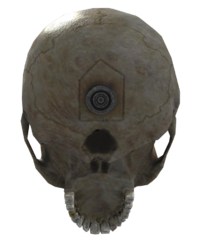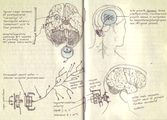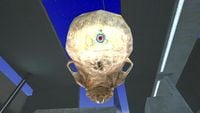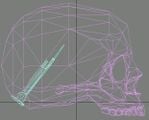Neural interface
From Halopedia, the Halo wiki
The neural interface, commonly known as a neural implant[1] or neural lace,[2] is a type of technology used by the UNSC.[3]
Functions
The basic function of the standard neural interface is to act as a "friend or foe" indicator, so that radar signatures will pick up the owner's signature and identify it as friendly. This way, the wearer appears as a "yellow" blip on the motion tracker of another soldier's heads-up display and friendly fire is less likely.[3] Additionally, the implant can be used to track and home in on its wearer in the event of capture by enemy forces, for example. While normally detectable under layers of rubble or rock, the signal is no longer reliable several meters underground.[4] More advanced models issued to key personnel possess a number of additional functions, including connections to data networks, enabling the wearer to coordinate with other command personnel as well as AIs and securely access sensitive data.[5] War Games training simulators employ the participants' neural interfaces to provide them with simulated sensory input to make the training scenarios more authentic.[6]
The neural interface is implanted at the base of the skull and can only be removed through sophisticated surgery.[7] The most basic interface, known as a "neural chip", is implanted in all UNSC military personnel upon activation, but it can be replaced with a more specialized neural lace should the need arise.[3] Ship commanders receive command neural interfaces, while the Spartans have received the more specialized "SPARTAN neural interface". The basic neural chip is completely embedded under the skin and possesses no external interface port, unlike the more specialized variations.[note 1]
Expensive and requiring complicated surgery when first introduced, neural interfaces and their mediating computing systems could be fitted in a simple outpatient clinical procedure by 2557. High-bandwidth interfaces can be paired with advanced expert systems to augment – and even bypass – the human motor system, reducing the physiological stress of high-performance combat exoskeletons to levels that do not require extensive skeletal reinforcement. This innovation, initially a secondary line of research during MJOLNIR’s early days, was crucial for the SPARTAN-III and SPARTAN-IV programs.[8][note 2]
Finally, neural interface is used by vehicle crews to allow them to use their vehicles more effectively. Most notable example of this is the Scorpion tank, where neural interface allows a single crewman to effectively control every function of the tank, rather than requiring a standard crew of driver, gunner and commander.[9] As standard issue neural interface chips used by infantry and starship crews lack an external port, it is likely that vehicle crews are issued with different neural interface chips which feature an external port.
Trivia
- The skulls in the Halo games have neural interfaces.
- Some Kig-Yar bounty hunters particularly love to go after heads equipped with neural interfaces when carrying out a mev-ut.[10]
Gallery
Fleet Admiral Terrence Hood's command neural interface.
The neural interface, as seen on the Oddball in Halo: Combat Evolved.
Notes
Sources
- ^ Halo: Combat Evolved, campaign level The Truth and Reconciliation
- ^ Halo: Combat Evolved, campaign level The Pillar of Autumn
- ^ a b c Halo: The Fall of Reach, page 118
- ^ Halo: Mortal Dictata, page 292
- ^ Halo: The Flood, page 57
- ^ Halo Waypoint: Canon Fodder - Beta Late Than Never
- ^ Halo: Glasslands, page 189
- ^ Halo Waypoint: Canon Fodder - Armory Amore
- ^ Halo: Combat Evolved, game manual
- ^ Halo: Glasslands, page 218
Cite error: <ref> tags exist for a group named "note", but no corresponding <references group="note"/> tag was found




